Planes are fast, trucks are local, but when it comes to moving the bulk of the world’s freight, ships rule. The sea freight forwarding process is what makes this possible. It’s the backbone of global trade and the most affordable way to move huge amounts of goods. Let’s break down how sea freight works and why the ocean freight forwarding process matters to businesses worldwide.
- What is sea freight forwarding?
- The Complete Sea Freight Forwarding Process
- Step 1 – Export Haulage (Pickup from shipper)
- Step 2 – Customs Clearance at Origin
- Step 3 – Cargo Handling and Port Processing
- Step 4 – Freight Booking and Vessel Loading
- Step 5 – Ocean Transit (Tracking and Visibility)
- Step 6 – Import Customs Clearance at Destination
- Step 7 – Port Unloading and Handling
- Step 8 – Import Haulage (Final Delivery)
- What Role Does a Sea Freight Forwarder Play?
- Planning and Documentation
- Booking and Carrier Coordination
- Customs Compliance and Support
- Providing End-to-End Shipment Visibility
- Types of Sea Freight Shipping Explained (LCL, FCL, and More)
- Less than Container Load (LCL)
- Full Container Load (FCL)
- Port-to-Port vs. Door-to-Door
- How Are Sea Freight Rates Calculated?
- Factors That Influence Costs (Weight, Volume, Distance)
- LCL vs. FCL Pricing Differences
- Seasonal and Fuel Surcharge Considerations
- Pros and Cons of Sea Freight Shipping
- Key Advantages
- Common Disadvantages
- Sea Freight vs. Air Freight – Which Is Right for You?
- Example Scenario: How a Sea Freight Shipment Works in Real Life
- Background: Small business exporting from India to Europe
- Process Walkthrough
- Challenges faced
- Outcome
- Takeaway Tips for New Shippers
- How Sea Freight Impacts Global Trade Today
- Connecting exporters, importers, and logistics providers
- Why freight forwarders are key players in the supply chain
- Frequently Asked Questions (FAQs)
- What exactly does a sea freight forwarder do?
- What is sea freight forwarding, and who needs it?
- What is the Sea Shipping Forwarding Process?
- What is the Ocean Freight Forwarding Process?
- What is the sea import freight forwarding process?
- Need Help With Your Next Shipment?
What is sea freight forwarding?
Sea freight forwarding is the process of organizing and moving goods across oceans using large cargo ships. It’s perfect for bulky or non-urgent cargo. A freight forwarder is the middle person who handles everything—from booking space on a ship, arranging customs clearance, managing container packing, and ensuring final delivery.
Basically, A freight forwarder makes sure your shipment gets from point A to point B without you having to worry about any of the chaos.
This is how the sea shipping forwarding process typically works—simple, step-by-step. Business of all sizes – from local exporters to global traders – uses freight forwarders to make sea transport easy, safe and more predictable.
The Complete Sea Freight Forwarding Process
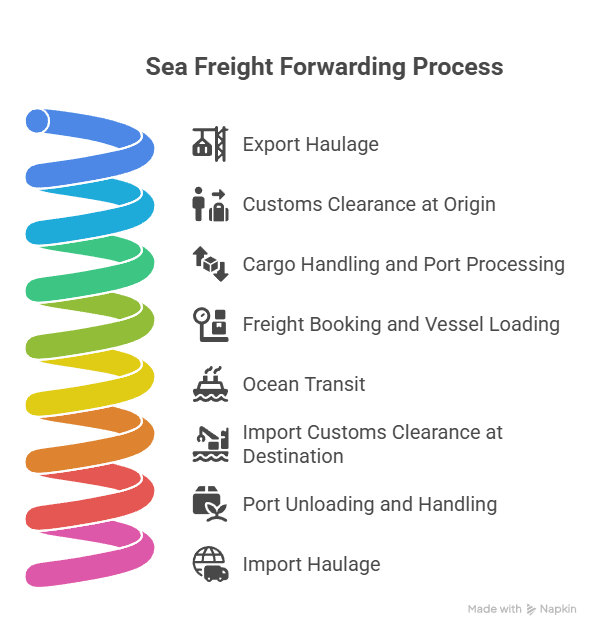
Step 1 – Export Haulage (Pickup from shipper)
The journey starts with export haulage, where your goods are picked up from your warehouse and taken to the freight forwarder’s location or directly to the port. This begins the full sea import freight forwarding process. This stage of the journey usually consists of trucks or small vehicles that carry your load to the inland locations to coastal loading hubs.
Step 2 – Customs Clearance at Origin
Before your cargo can leave the country, it needs to clear customs. It includes paperwork such as invoices, packing lists, and licenses. The freight forwarder manages all of this to avoid any hold-ups. This step makes sure everything follows local export rules and that your shipment won’t get delayed due to missing forms.
Step 3 – Cargo Handling and Port Processing
Once at the port, your goods are weighed, inspected, and loaded into containers. This step includes proper container packing to ensure safety during transit. It’s a crucial part of the Sea Shipping Forwarding Process. Skilled port workers organize containers using the crane and check the damage before transferring the load to the dock for staging.
Step 4 – Freight Booking and Vessel Loading
The forwarder books space for your shipment—a key piece of the Ocean Freight Forwarding Process. Once booked, your cargo is loaded onto the ship. Shipping lines assign containers a place on board, and port teams handle the loading based on vessel layout and route efficiency.
Step 5 – Ocean Transit (Tracking and Visibility)
Now your cargo sails across the ocean. Using tracking systems, your forwarder provides updates along the way. This is the core of how sea freight works. Transit can require a few days or even several weeks, depending on where the cargo is coming from and where it is going. Weather, port stops, and maritime traffic can affect timing.
Step 6 – Import Customs Clearance at Destination
Once the ship docks at its destination, your cargo needs to go through another round of customs clearance. The forwarder manages it again, so you don’t have to. This includes depositing import permits, paying customs duties and working with customs brokers.
Step 7 – Port Unloading and Handling
When your container is taken off the ship, it will be handled at the port and arranged for the last part of the journey. Sometimes goods are stored temporarily in bonded warehouses until everything is cleared. Port workers sort and stage the containers for inland delivery.
Step 8 – Import Haulage (Final Delivery)
In this final phase, your goods will be transported from the harbor to your final destination – your warehouse, office, or customer. Trucks, vans, or rail services are used to finish this leg of the Step-by-Step Sea Freight Forwarding Process.
Every shipment goes through the same process of sea freight forwarding—pickup, customs, port handling, vessel transit, import clearance, and delivery. Each link in the chain matters. A reliable forwarder manages the sea import freight forwarding process so businesses can focus on sales and operations rather than shipping challenges.
What Role Does a Sea Freight Forwarder Play?
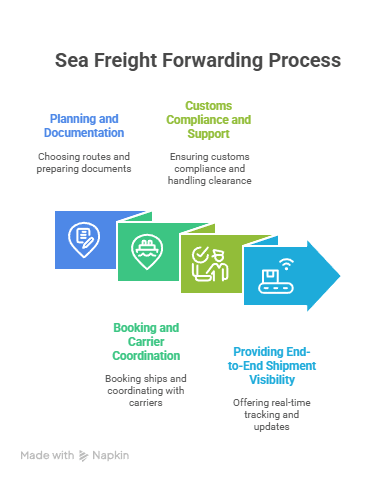
Planning and Documentation
They choose the best freight routes and prepare important documents such as the Bill of Lading. They also recommend reducing costs and avoiding delays.
Booking and Carrier Coordination
They handle booking the ship and working with carriers to secure space. Forwarders often have relationships with multiple shipping lines, giving clients more flexibility.
Customs Compliance and Support
They make sure your shipment meets all customs rules, handling customs clearance on both ends. They stay updated on regulation changes and advise on duties and taxes.
Providing End-to-End Shipment Visibility
They give real-time tracking and updates from pickup to final delivery. Some also offer client portals or digital dashboards so you can able to track your goods in real time.
The role of a freight forwarder in the sea freight forwarding process is all about control and clarity. They plan, document, book, and manage customs while offering tracking tools that show you in real time how sea freight works—from your warehouse to the destination port.
Types of Sea Freight Shipping Explained (LCL, FCL, and More)
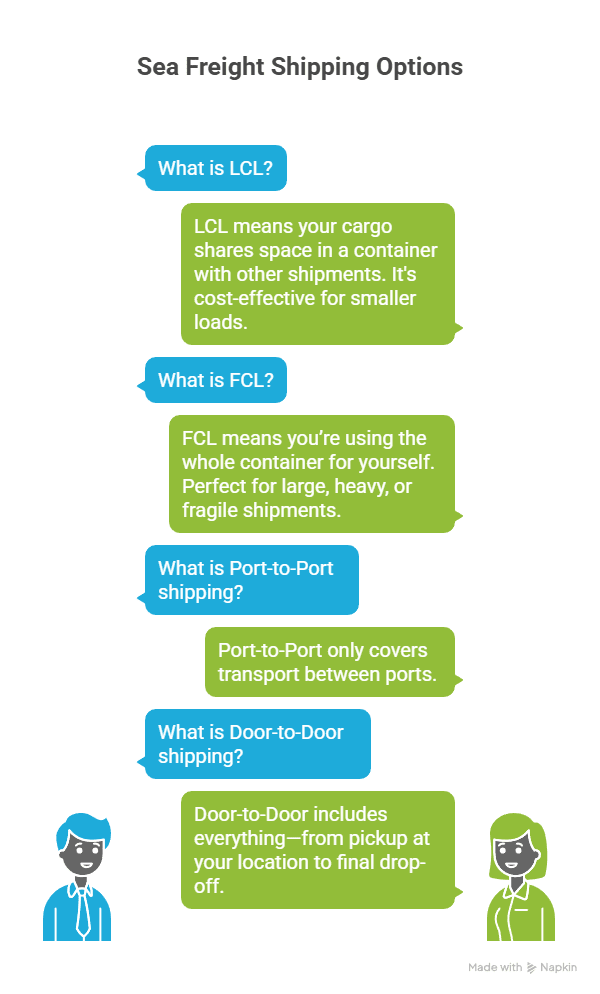
Less than Container Load (LCL)
LCL means your cargo shares space in a container with other shipments. It’s cost-effective for smaller loads. This option is great if you don’t have enough goods to fill a full container.
Full Container Load (FCL)
FCL means you’re using the whole container for yourself. Perfect for large, heavy, or fragile shipments. It often reduces handling, lowering the risk of damage.
Port-to-Port vs. Door-to-Door
Port-to-Port only covers transport between ports. Door-to-Door includes everything—from pickup at your location to final drop-off. Most businesses go door-to-door for convenience.
When it comes to the ocean freight forwarding process, businesses usually choose between LCL or FCL. LCL is budget-friendly for smaller shipments since you share container space, while FCL gives you an entire container for safety and scale. The process of sea freight forwarding also varies, some prefer simple port-to-port shipping, while others go door-to-door for full convenience.
How Are Sea Freight Rates Calculated?
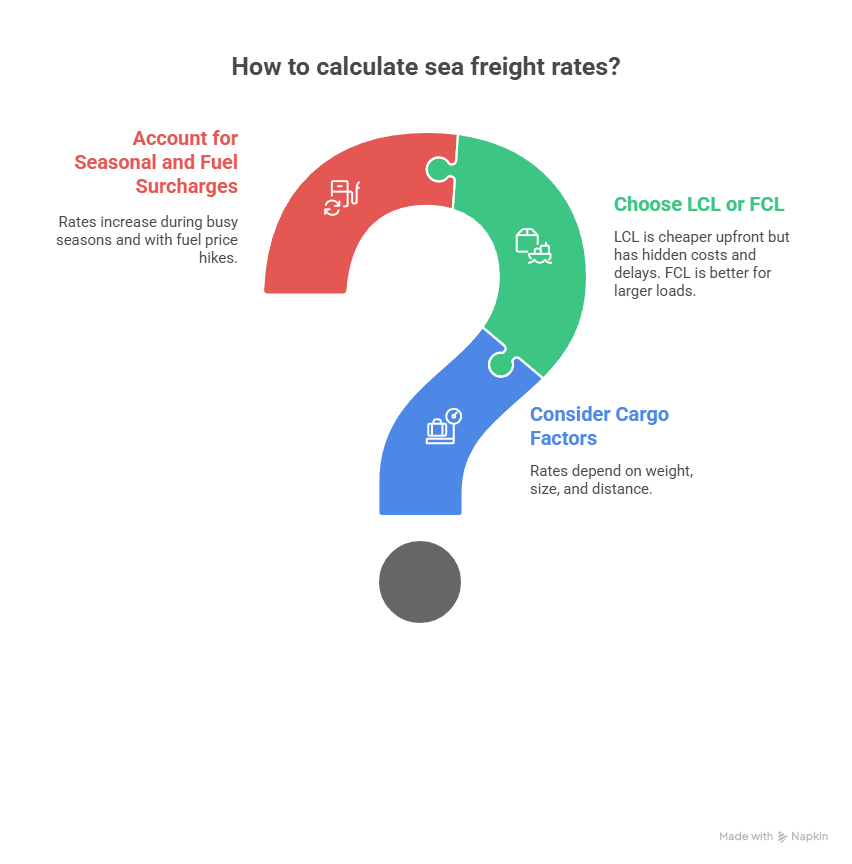
Factors That Influence Costs (Weight, Volume, Distance)
Rates usually depend on your cargo’s weight, size, and the distance it needs to travel. The cost of heavy or bulkier items is high, especially on long international routes.
LCL vs. FCL Pricing Differences
LCL might be cheaper upfront, but costs can add up due to handling fees. FCL is often better for bigger loads. In addition, transit time for LCL can be long as the load is consolidated with others.
Seasonal and Fuel Surcharge Considerations
Busy seasons combined with fuel price hikes may result in higher rates. Holidays and periods of high demand not only affect rates but also lead to less vessel space available.
Every shipment cost is tied to the sea shipping forwarding process. Bulkier or heavier cargo pushes rates up, while distance multiplies the expense. LCL may seem affordable, but hidden fees and delays can change the picture. FCL works out better for larger volumes. And since the sea import freight forwarding process is sensitive to fuel prices and seasonal demand, timing matters too.
Pros and Cons of Sea Freight Shipping
Key Advantages
- Cost-effective for large and heavy cargo
- Ideal for hazardous or non-urgent goods
- Lower carbon footprint than air freight
- Safer for oversized machinery and goods that don’t need quick delivery
Common Disadvantages
- Slower transit times
- Weather or port issues can cause delays
- More customs paperwork and handling are needed
- Less flexibility for tight delivery deadlines
Choosing sea freight means weighing both sides. Choosing the right sea freight forwarding process cuts costs for large shipments, supports greener logistics, and provides safety for non-urgent cargo. But it’s slower, more paperwork-heavy, and less flexible. Understanding how sea freight works makes it easier to decide if the benefits outweigh the limits.
Sea Freight vs. Air Freight – Which Is Right for You?
| Feature | Sea Freight | Air Freight |
| Cost | Lower for bulk | Higher overall |
| Speed | Slower (days–weeks) | Fast (1–5 days) |
| Ideal For | Heavy, non-urgent cargo | Time-sensitive shipments |
| Environmental Impact | Lower emissions | Higher emissions |
| Documentation | Requires customs documents | Requires fewer forms |
| Risk of Delay | Moderate | Low |
Example Scenario: How a Sea Freight Shipment Works in Real Life
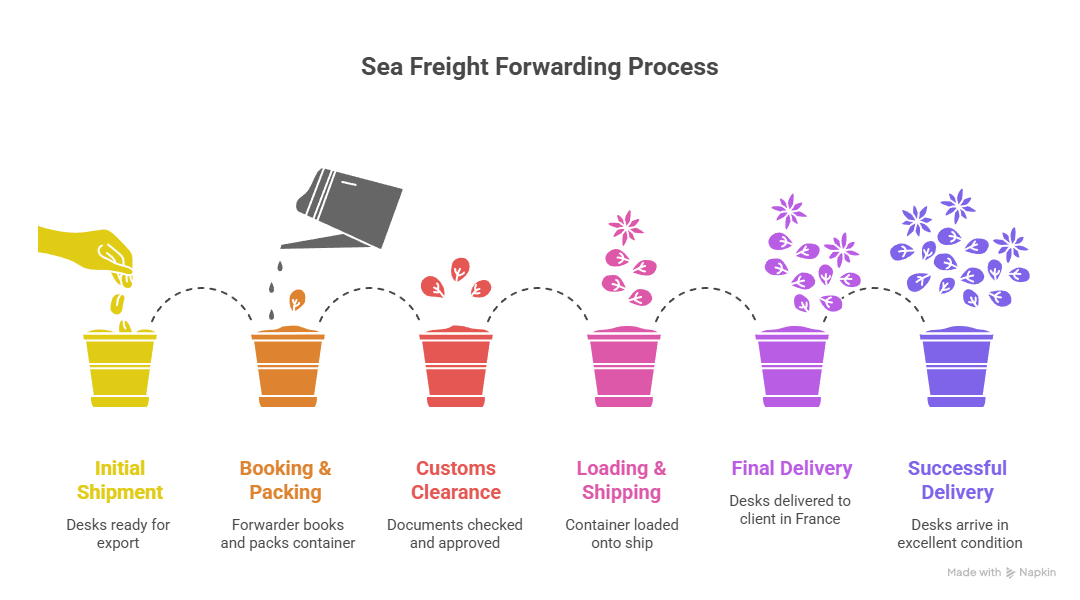
Background: Small business exporting from India to Europe
A furniture maker in Dubai ships office desks to a client in France. They hire a sea freight forwarder to handle it all.
Process Walkthrough
The forwarder manages booking, container packing, customs clearance, loading, and final delivery using the full Step-by-Step Sea Freight Forwarding Process. The desks are shipped via FCL for better security.
Challenges faced
Some documents had errors, and a storm slowed the ship. But the forwarder fixed things fast using tracking tools and local agents at the port.
Outcome
Desks reached France in great shape. The client was happy. The company understood the sea import freight forwarding process better and now uses sea freight regularly.
Takeaway Tips for New Shippers
- Label cargo clearly
- Double-check documents
- Pick a good forwarder
- Be aware of peak seasons
In practice, the sea shipping forwarding process can look like this: a small business exporting desks to France through FCL. The forwarder managed every step, from customs paperwork to unloading. Delays from weather and document errors were quickly solved. The takeaway? When you know the process of sea freight forwarding, hiccups don’t stop business growth.
How Sea Freight Impacts Global Trade Today
Connecting exporters, importers, and logistics providers
Sea freight moves huge amounts of goods daily. It keeps businesses running across the world. From raw materials to finished products, ships carry it all.
Why freight forwarders are key players in the supply chain
They deal with complex tasks so businesses don’t have to. From booking to delivery—they make trade work. Without them, delays, fines, and confusion would be far more common.
Global trade wouldn’t work without the ocean freight forwarding process. Every day, freight forwarders connect exporters and importers by organizing routes, handling paperwork, and ensuring smooth transport. Their expertise in the sea import freight forwarding process means fewer fines, faster deliveries, and stronger supply chains.
Frequently Asked Questions (FAQs)
What exactly does a sea freight forwarder do?
They manage booking, paperwork, customs clearance, shipping, and final delivery.
What is sea freight forwarding, and who needs it?
It is perfect for anyone shipping large, heavy, or international goods across oceans.
What is the Sea Shipping Forwarding Process?
From booking and customs clearance to loading and delivery, it’s the full ocean transport process.
What is the Ocean Freight Forwarding Process?
Same as above, but often used for longer international routes.
What is the sea import freight forwarding process?
It definitely has its journey overseas and ends when the goods are delivered to your local address.
Need Help With Your Next Shipment?
The ocean freight forwarding process connects businesses to global markets. It may involve many moving parts, but with expert coordination, it’s the most effective way to move goods worldwide.
That’s exactly what Triroute Shipping, a sea freight shipping company in Dubai, UAE, delivers: trusted support and seamless management of the entire sea freight forwarding process.






